柿堺香老师-越南演奏会
http://www.nipponica.jp/index.htm
这次的演奏会主要由日本指挥家 本名彻次指挥 "日本Orchestra Nipponica"与"越南国家交响乐团"合作演出,由正式演出之前的几次排演,看得到专业的不同凡响,即使是来自两个全然不同的国家. 指挥家 本名彻次 多次来回日本,越南二地,分别训练相隔6-7小时航程之外的两地团员,11月23日全天,24日下午,两天的第一次共同排演,24日晚间正式上场就能完美的演出2个小时几无间断的节目,真的让人佩服这群音乐家的专业.
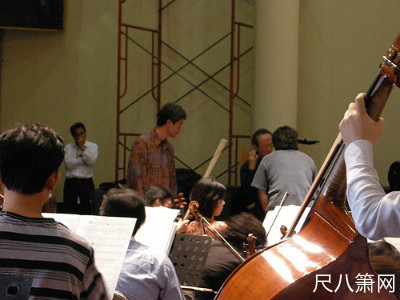
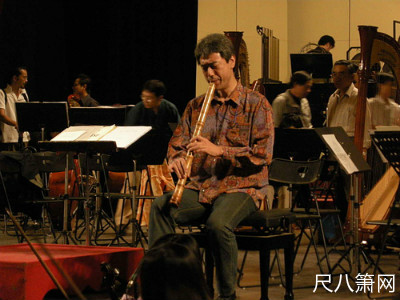
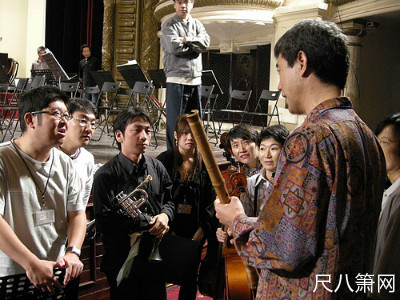
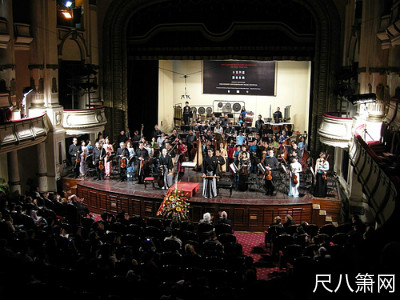
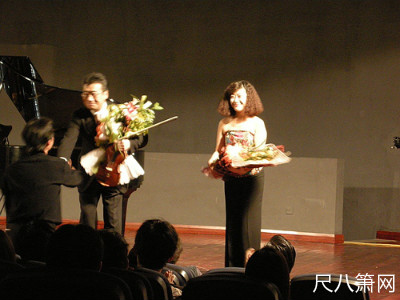
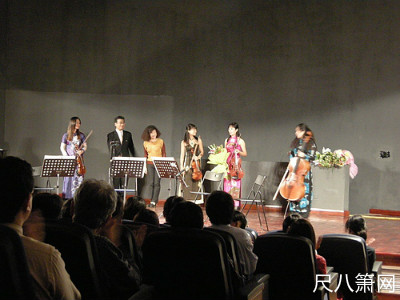
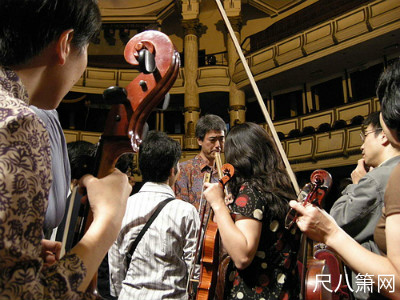
(上图)与本名彻次指挥讨论演出细节.(排演地点距离河内市区约30分钟车程,该场地属于交响乐团团练时专用.)
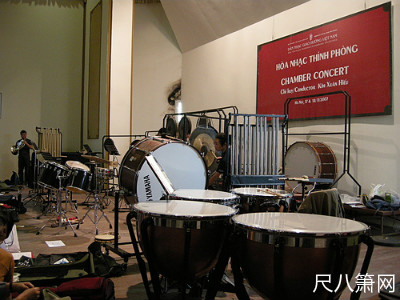
(上图)与越南国家交响乐团排演.
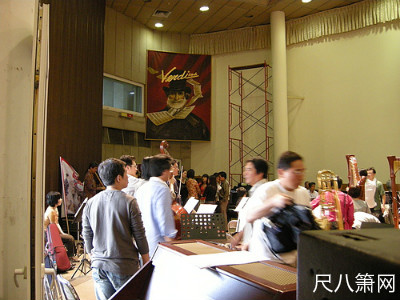 (上图) Honai Opera House正式排演
(上图) Honai Opera House正式排演
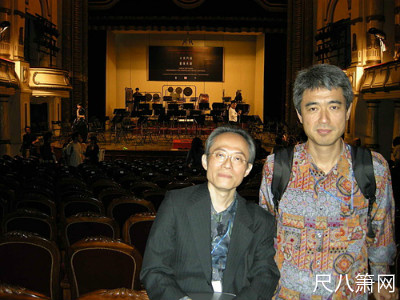
(上图) 柿堺香,中村鹤城 老师 - 24日下午排演结束
11月22日晚上有点像是暖身性质的小型演奏会,以日本的钢琴与小提琴家演出前半段,后半段则由越南四位美丽演奏家的弦乐四重奏演出.曲目部份则以日本,越南作曲家的创作曲目为主.
(上图) 22日晚上,日本小提琴家,钢琴演奏家于小型音乐会前半段结束后接受献花.
(上图) 22日晚上,小型音乐会结束后,日本,越南演奏家接受献花.
11月24日则以交响乐团的演奏为主,由日本,越南的交响乐团团员组成一个完整的乐团(比例约7:3),曲目部份则以四位日本作曲家的曲目,搭配一首越南作曲家的创作曲目为主.当中包含柿堺香,中村鹤城 老师演奏武满彻的November Steps.
(上图) 11月24日晚上November Steps在河内国家音乐厅(Honai Opera House)的正式演出.
距离 横山胜也老师1967年第一次演出刚好满40年.第一次近距离的看November Steps的演出,确实能感觉到为何这首曲子能够在40年来,一而再,再而三的在重要的音乐舞台上被拿出来表演,也能确实感觉到它的演奏难度. 在舞台上不使用麦克风,配合管弦乐团的庞大音压, 但却必需让人清楚感受到它的存在,必需让整个演奏厅的每一位听众听的很清楚,更重要的是必需让听众感受到尺八的"唯一"特色,真的相当的困难.
当我们在听西洋古典乐曲时,有些乐曲你可以清楚的知道这是一首为某种乐器编写的曲目,但有许多乐曲却能以不同的乐器演奏出同样吸引人的旋律与感受.在这裡,唯一可以肯定的是,这是一首专属尺八的交响乐曲.
有趣的是,预演完后,因为当天"November Steps"预演时间排在最后时段,预演完后,大家都等著几个小时后的正式演出,有很长的空档时间,看到一群日本,越南的管弦乐团的年轻团员展现的好奇心与惊讶的表情,围著尺八演奏者,问题持续了近20分钟,觉得很有趣.
如果把时间拉回到40年前,横山胜也第一次演奏November Steps,或许真的让观众,作曲家,乐团团员看到了尺八的无限可能.或许尺八不像小提琴,永远佔据音乐舞台的最重要位置,但在属于自己的角落,却可以带给多数人全然不同的想像空间.
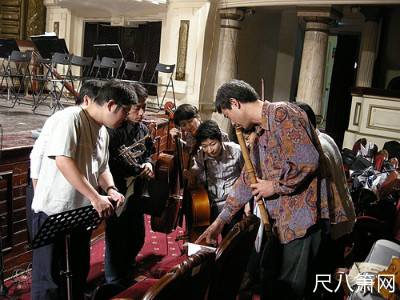
(上图) 柿堺香 老师解释尺八谱的使用, 其实看不懂尺八谱的不是只有外国人,日本人也是有看没有懂的佔绝大多数.
======================================
芥川也寸志メモリア儿 オーケストラ?ニッポニカ
日越友好合作现代音楽祭
古楽同源?新楽共创 in ハノイ
■室内楽演奏会
2007年11月22日(木)20时开演
L’Espace(ベトナム?ハノイ)
レクチャートーク ~ベトナムの作曲家を交えて~
司会:小沼纯一 氏(早蹈田大学教授)
Nhat Tan 氏/石田匡志 氏(作曲家)他
芥川也寸志 谭诗曲(Ballata per violino e pianoforte) ベトナム初演
石田匡志 「断章」~弦楽四重奏のための
委嘱作品?世界初演
石井眞木 失われた响き?Ⅰ ヴァージョンa ベトナム初演
Vu Nhat Tan 弦楽四重奏のための「雨」 委嘱作品?世界初演
弦楽四重奏 Hua Sen Vietnam Quartet
Violin 深山尚久
Piano 三轮 郁
■オーケストラ演奏会
2007年11月24日(土)20时开演
ハノイ オペラハウス(ベトナム?ハノイ)
早坂文雄 「左方の舞之右方の舞」 ベトナム初演(1941)
武満 彻 「ノヴェンバー?ステップス」 ベトナム初演(1967)*
藤田正典 オーケストラのための「いにしえの飞鸟へ」
委嘱作品?世界初演(2007)
今井重幸 オーケストラのための「仮面の舞」第5番 委嘱作品?世界初演(2007)
Do Hong Quan オーケストラのための?Act One? 委嘱作品?世界初演(2007)
琵琶独奏* 中村鹤城
尺八独奏* 柿堺香
指挥 本名 彻次 (ニッポニカ音楽监督)
管弦楽 オーケストラ?ニッポニカ
==========================================
武满彻(Toru Takemitsu )
文章作者: SHIHLUN
资料来源: http://www.wretch.cc/blog/shihlun/6958827
已故的作曲家武满彻,是日本现代音乐的代表人物。他擅长将东瀛传统乐器搭配西方古典音乐编制,藉此打造出既具当代感,却又呼应日式传统美学的现代音乐1931年出生的武满彻,少年时代正值第二次世界大战,军歌及爱国歌曲以外的音乐,均遭日本军事政府禁制。但某日,一名同僚年轻士兵拿出暗藏的法国香颂唱片播放。在最苦的时代裡,却听到对另种世界的美好想像,感动的武满彻从此下定决心,战争若是结束,要将音乐当作他一生的志业战后自学音乐的武满彻,和他同代的日本创作者,都面临同样的挑战:如何一方面承认西方的影响,二方面能在这新的历史脉络下,找出日本传统文化的新生机。为了克服这个困境,武满彻实验将东方乐器融入西方交响乐编制中,却又能避免让这些东方式的声音,不至于沦为西方声响下的背景点缀或异国情调。诸如尺八、琵琶、三味线等乐器,从此有了当代面貌的新生命武满彻曾言西方的音乐哲学观,彷彿一条起承转合分明的「直线」道路。但他将音乐视为一个自己自足的小宇宙,彷彿置身于日式传统庭园中,作曲家的任务,是在此音乐庭院中置放各种元素,并且适当留白,让聆听者藉此感受到生命的兴衰荣枯、不断循环,而旅途终点,即是起点。武满彻将自己的音乐比喻为日式庭院,因为其观赏路径多是「圆形」的,此乃东方式的哲学观与生命观。
武满彻作品众多,代表作包括 《November Steps》, 《In An Autumn Garden,》等,电影配乐成就亦高,经典包括小林正树的《东京审判》、《切腹》、《怪谈》;今村昌平的《黑雨》、黑泽明的《乱》、《电车狂》;勅使河原宏的《沙丘之女》、《他人的脸》、大岛诸的《爱的亡灵》等,不胜枚举。
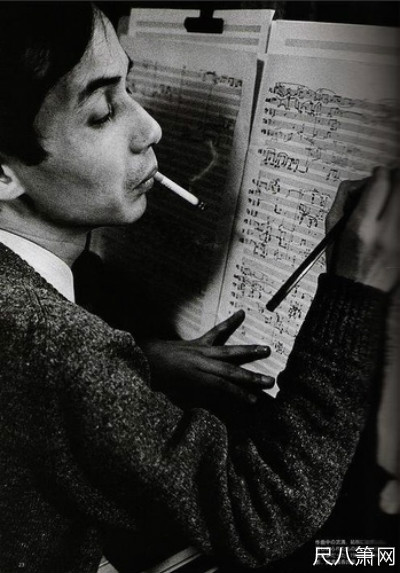
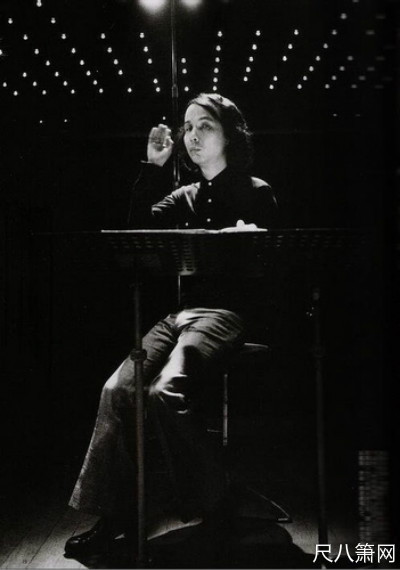
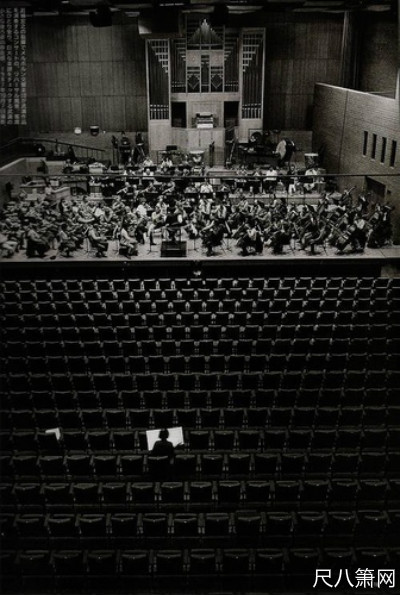
下文为读卖新闻英文版对武满彻十週年纪念展的报导
The many dimensions of Toru TakemitsuPaul Jackson / Daily Yomiuri Staff WriterAn art exhibition about a composer? Surely Tokyo's Opera City complex is getting a little carried away in marking the 10th anniversary of Toru Takemitsu's death? He may have been Japan's most famous 20th-century composer, but is there a need to commemorate his legacy with an art exhibition? Well, actually, yes. While Takemitsu is known throughout the world of contemporary and classical music for his unique atmospheric compositions, his life also provides an inspiring example of eternal curiosity and a striving to cut across artistic boundaries. Takemitsu may have more obviously delved into the avant-garde of contemporary music, and introduced Western audiences to a Japanese aesthetic, but he also had contact with experimental artists outside the realm of music from poets and photographers, to painters and filmmakers. And this desire was not just to work in various mediums, it was to create new ones. This legacy is an important and symbolic one for Opera City itself, too, as Motoaki Hori, chief curator of the exhibition Toru Takemitsu--Visions in Time, explains. "Between 1995 and 1996 Toru Takemitsu was artistic director of Opera City. While the first concerts didn't take place here until 1997, after he died, the ideals he sketched out remain," Hori said. "You can see in the exhibition that in Takemitsu's career there were painters, artists and musicians, people from different disciplines getting together to produce something new. I think the ideal Takemitsu had for this [Opera City] foundation with its art and music...was for a new 21st-century art culture to be born from various genres." The nine-section exhibition sprawls through 10 rooms and two floors of Tokyo Opera City Art Gallery and features work by those who influenced or inspired Takemitsu such as Miro, Man Ray, Isamu Noguchi, Jasper Johns, Sam Francis and Odilon Redon. Visions in Time sets out to portray the many facets of Takemitsu. A chronological element runs through most of the exhibition, but a comprehensive time-line analysis of each significant moment in Takemitsu's career it is not. Visitors looking to confirm the story that Stravinsky first heard Takemitsu's 1957 Requiem for Strings by accident after the wrong part of a tape recording was played, will leave the exhibition none the wiser. What they will come away with is a feel for the different dimensions of Takemitsu--not just the avant-garde composer with the strong Japanese aesthetic, but also Takemitsu the painter, Takemitsu the critic, Takemitsu the event coordinator, Takemitsu the film score producer.
Among the more interesting exhibits on display that shed light on Takemitsu are an animated alien slide show; handwritten musical notation featuring Japanese instrumentation and a clipping from Time magazine; a storyboard from a Kurosawa film; and an image of a "pianist's crown" that is both a painting and a musical score. </p>
<p>The alien slide show dates from Takemitsu's 1950s involvement in the Jikken Kobo (Experimental Workshop), a group of poets, painters, photographers and sculptors who looked to fuse together disciplines in the hope of sparking off whole new genres of art. The animation is actually a black-and-white filmed version of a slide show depicting a visitation by Miroesque aliens with a weird, unsettling soundtrack by Takemitsu. In this day and age it would be called an installation.
The musical notation comes from a handwritten score for November Steps, the piece Takemitsu was commissioned to write for the New York Philharmonic's 125th anniversary in 1967. The piece is famous for its inclusion of shakuhachi and biwa, whose parts can be seen toward the end of the score written above those written for harps, violins, violas and other instruments.
The cutting from Time reviews the performance of the work and is an indication of its significance. The accompanying photograph shows the short, angular appearance of Takemitsu alongside a youthful-looking Seiji Ozawa, who conducted the performance. In the text, Takemitsu is quoted as saying he dips into the river of sounds around him and merely tries to ascertain what he manages to fish out.
The first work he did with Japanese instrumentation was Eclipse. This was pretty well received and the next year he did November Steps," Hori explains. "But Takemitsu was worried about just adding a Japanese biwa or shakuhachi into a Western musical setting. Westerners would just enjoy it for its exoticism without understanding it. In the end, he wrote that he was glad he did it, but he didn't keep writing pieces like [November Steps]. He wanted to find other compositional approaches."
Rather than pushing Japanese instrumentation for what he perceived would be short-term novelty, he was determined to have a more lasting impact by imbuing music composed for Western instrumentation with a natural Japanese aesthetic.
The recorded strains of what sounds like a shakuhachi at the exhibition bear this point out, because it isn't a shakuhachi, it's a flute played with a shakuhachi feel. </p>
<p>In 1965 Takemitsu moved to Miyotamachi in Nagano Prefecture and came into more contact with nature than before. The sound of the wind, water, the rustling of trees, these natural sounds and textures are very much part of a Japanese musical aesthetic that can be found in Takemitsu's music.
A piano he used when composing in Miyotamachi is on display. Symbolically placed in front of the stool is a heavy tome of Debussy compositions, while on top of the piano works by Messiaen and Ligeti straddle the music for the Beatles' Sgt. Pepper--Takemitsu, for all his avant-garde experimentation could also relate to pop music.
The "pianist's crown" on display is actually a collaborative work, Corona for Pianists by Takemitsu and Kohei Sugiura. What looks like a painting of superimposed television aerials around a circle is actually a graphic musical score, with its own code and logic. This is one of many examples in the exhibition of the influence on Takemitsu of iconoclastic contemporary composer John Cage, with whom Takemitsu became a close friend. It's also an example of a literal merging of painting and musical composition.
For another work, Seasons, the codification of triangles, circles and arrows is explained, creating an image of the kind of bizarre experimentation that took place at the time. Among the codified instructions are those to "accumulate" sound, imitate the playing of the person to your left, and to improvise statements about the weather using language taken from atmospheric reports, weather forecasts and astrology.
More conventional work was produced by Takemitsu for the cinema and a collection of film posters lines one of the walls of the exhibition. A storyboard for Kurosawa's Ran is on display along with a section of the score, but here the gallery really should have provided some headphones for visitors to listen to what they could see to maximize the multimedia experience. That said, 25 of the 100 or so films Takemitsu wrote music for will be screened at the exhibition during Golden Week.
All in all, the exhibition works best on the level of sketching a wider outline of Takemitsu rather than as an exhibition of art per se. But it should have visitors thinking more about the potential for artistic endeavor beyond specific genres.
These days people aren't interested in so many things, they decide on one thing and get nerdish about it," Hori said. "But Takemitsu was brimming with curiosity. He was into film, contemporary, classical and traditional music, art...He had antennas tuned into all kinds of things. It was a habit of his to think deeply and try to understand things.He was into everything.
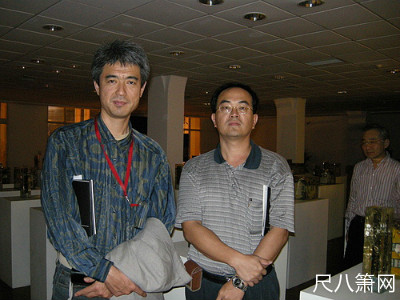
转自台湾山城老师博客:blog.xuite.net/shakuhachi.taiwan
评论列表: